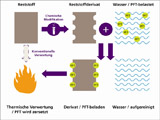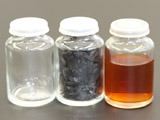IFAT 2014
Clean drinking water with optimized separation processes
At the 2014 IFAT, from 05 May to 09 May 2014 in Munich, the Oberhausen-based Research Institute Fraunhofer UMSICHT will present, as the focus of its trade-fair appearance, examples of developments in process-intensified coated micro sieves and cellulose-based, chemically modified adsorbents as new separation materials. Activities regarding renewable resources will also be presented: on the one hand, thermo-catalytic reforming for energy conversion and storage, on the other, new utilization concepts for material and energetic utilization of biomass within the scope of the innovation cluster »Bioenergy«.


In many parts of the world, drinking water that is safe with respect to hygiene and toxicology, is a resource that is as precious as it is finite. Filtration processes are able, by means of targeted separation of material streams into individual, renewable components, to close hydrological cycles, clean waste water and turn regular water into drinking water. At Fraunhofer UMSICHT, filtration processes are optimized and micro filters are produced for water technology. Within the framework of the nanoEfficiency project sponsored by the German Federal Ministry of Education and Research (BMBF) a coating process for micro filters was developed that created layers that have an antifouling effect. They are no thicker than 100 nanometers, anticorrosive and extremely durable. There are no fouling layers forming even after prolonged use that affect the filtration performance negatively.
Environmentally friendly reclamation of strategic metals
The demand for rare earth metals (REM) or elements of the platinum group (PGE) is increasing continuously. The growing scarcity of these strategic raw materials, the in part high dependency on imports and insufficient recycling rates motivated S-Sieve, a cooperation project (sponsored by the AiF) of Fraunhofer UMSICHT with the Helmholtz-Zentrum Dresden-Rossendorf (HZDR) and the Institute for Process Research, Environmental and Mining Research (Institut für Verfahrens-, Umwelt-und Bergbauforschung IVUB e. V.). To reclaim dissolved metals from aquaeous systems, an organic composite material, consisting of surface layers (S-layer, protein layers) and new types of micro sieves, was developed. Micro sieves were coated with proteins that were created by bacteria (S-layer proteins) which can bind metals such as platinum, palladium or gold. We also expect good binding characteristics for various representatives of the rare earth metals. The coated micro sieves can be used several times since they can be regenerated by means of a pH shift or various rinsing processes.
Accordingly complex micro sieves are produced at Fraunhofer UMSICHT via an ultra-short pulse laser which creates the smallest of microstructures down to a micrometer. The laser can process almost any materials, even the pore patters can be set as desired.
Separation of shorter-chained perfluorinated tensides
Another new separation material are the cellulose-based, chemically modified adsorbents that separate perfluorinated tensides (PFTs) out from water. PFTs are used in various areas, such as in water and dirt-repelling coatings for textiles and as wetting agents and mist suppressants in electroplating. They are persistent, which means that they are not bio-degradable and also cannot be destroyed with the usual processes. Longer-chained PFTs such as perfluorooctane sulfonate (PFOS) can be removed relatively well with conventional activated charcoal and are, by now, mostly prohibited. For this reason, the scientists of Fraunhofer UMSICHT have focused on the shorter-chained, hydrophilic substances. These include, for example, perfluorobutanesulfonic acid (PFBS). The already patented adsorbers that were developed in cooperation with Cornelsen Umwelttechnologie GmbH are based on hemp shives and wood chips. In the future, after loading, the adsorbents are to be burned at high temperatures, which also would separate the PFTs into their elements and thus no longer present a burden to the environment.
New utilization concepts for material and energetic utilization of biomass
The material and energetic utilization of biomass will, in the future, constitute an important contribution to covering the worldwide raw materials and energy needs. In addition to treating dry biomass, the Fraunhofer Innovation Cluster Bioenergy is looking at primarily wet biomass and biomass containing lignocellulose. Both mobile and decentralized usable technologies are to be provided to manufacture storable and transportable intermediate products from biomass containing lignocellulose and/or wet biomass as well as corresponding residues, such as vegetable charcoals, pyrolysis oil, dried and dehydrated biomass as energy source or for further use. Potential materials to be used are straw, biowaste and green waste materials or production residues from the foodstuffs industry. With its location in North Rhine-Westphalia, the Innovation Cluster is located in a region that is characterized by agriculture, the energy and the (petro)chemical industry. Many well-known companies have their headquarters or a regional presence here. The dense network of universities and university institutions, furthermore, provides the best opportunities for access to innovative research. The region can therefore present itself as key region for the bioenergy area. The cluster is sponsored by the Ministry for Innovation, Science, Research and Technology of the German state of North Rhine-Westphalia (MIWF) with funds from the European Fund for Regional Development and funds from the Fraunhofer-Gesellschaft.
Energy conversion based on organic residues
Thermo-catalytic reforming, which was developed at Fraunhofer UMSICHT at the Sulzbach-Rosenberg branch of the institute, can provide an eco-friendly contribution to changing our energy situation. Through a multi-stage thermo-chemical process, various organic waste materials such as farming waste materials, sewage sludge and recycling waste materials from the paper industry are turned into oil, gas and biocoke. In a robust and continuous process, the systems convert more than 75 percent of the energy being supplied into high-quality energy sources. For the biocoke that is produced, it is possible to envision a use as soil conditioner. Due to a very efficient use of capital, the decentralized use of semi-mobile units is made possible. The high degree of flexibility regarding the potential feed materials and the product recovery paths promises a very high level of investment security.
The numerous biogas plants represent an initial great potential for the process in Germany. The fermentation residues from the anaerobic fermentation can be converted and transformed into liquid, firm or gaseous products. Through the subsequent phase separation the liquid phase will then be separated into an aqueous and an oil phase. The separated-off process water, which contains a high level of short-chained, biologically degradable carbon compounds, can be returned to the biogas plant and contribute to the increase in methane output. The produced and processed reform oil and the gas are used to generate electricity and heat in a combined heat and power plant (CHP); the solid residue is suitable for agricultural purposed as a soil conditioner, for example.
Last modified:
 Fraunhofer Institute for Environmental, Safety and Energy Technology UMSICHT
Fraunhofer Institute for Environmental, Safety and Energy Technology UMSICHT